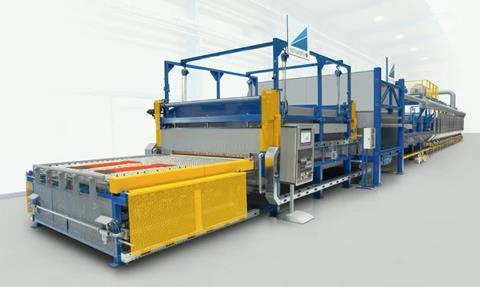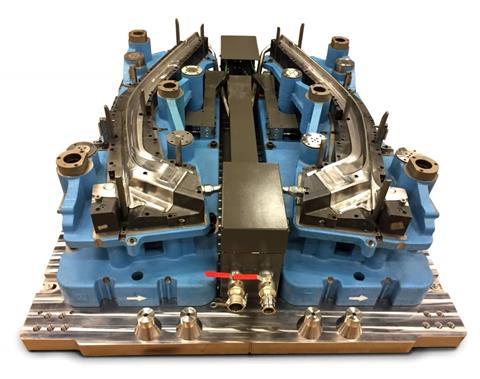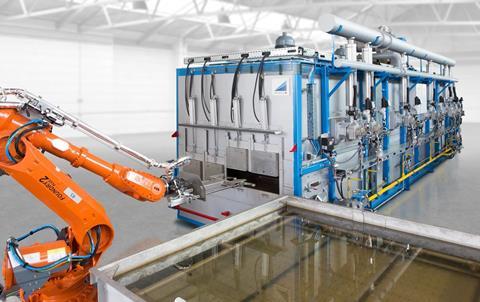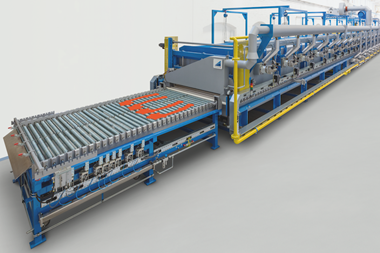Heat treatment specialist schwartz has enhanced its system for tailored tempering – one that is capable of ‘printing’ components

Press hardening has established itself as an exceedingly cost-efficient and versatile-to-employ process for making very strong, yet lightweight, automotive safety components. It has evolved into a standard technology in automotive manufacturing.
Aimed at achieving a controlled deformation and improved vehicle occupant protection in the event of a crash, the technology can produce automotive bodywork parts exhibiting made-to-measure strength and elongation characteristics in different zones.
Through its thermal printing technology, schwartz has launched an economical method of obtaining parts with tailored properties – so-called tailored blanks – and has consistently advanced this capability to the industrial viability stage. Thermal printing can create multiple regions of different strength and elongation behaviour in a single component, each with a defined transition zone of distinct narrowness or width. What is more, the process can be completed by using conventional press tooling.
Reduced cycle time
In order to bring the manufacture of such ‘tailored tempered blanks’ even closer to practice for the benefit of its customers, schwartz has set up a full-scale trial line at its headquarters in Simmerath near Aachen, Germany.
Numerous customer specifications for high-strength and softer product zones, plus the associated defined transition areas, have been tested here. The system is capable of ‘printing’ components measuring up to 2,500mm in length. In designing the line, special care was taken to optimise parameters that are key in automotive volume production.
“Through its thermal printing technology, schwartz has launched an economical method of obtaining parts with tailored properties – so-called tailored blanks – and has consistently advanced this capability to the industrial viability stage.”
Among other advances, the engineers managed to cut the replacement time for the part-specific printer cartridge to less than the die-change time. In addition, it is possible to produce parts with two, three or even more different strength zones.
A significant reduction in cycle time has been achieved for two zone parts as well. The original cycle time of less than 35 seconds is now down to under 20 seconds. Likewise, the consumption of cooling medium was reduced substantially, as was noise emission.
Thus, schwartz enables its customers to explore the full range of feasible part specifications to optimise parameters and to boost their manufacturing cost efficiency through faster part changes and short cycle times.
Leading the way
schwartz has been named a world market leader in the field of heat treatment plants for the press hardening of steel. The World Market Leader Index Germany relies on an objective and transparent selection process and regularly determines the world market leaders in co-operation with the University of St. Gallen.

The schwartz group
Heat treatment in a schwartz system prior to the subsequent pressing step makes steel auto body components substantially stronger. Inside the vehicle, these parts yield a significantly higher crash safety for the occupants. Moreover, given their superior strength, they can be made thinner. This provides additional savings in car weight and improved fuel efficiency. Through the use of aluminium suspension parts, automotive suppliers can further enhance the energy efficiency of their cars.
Heat treatment systems made by schwartz are designed and built individually to match specific user requirements, relying on expertise and experience gathered since 1984: schwartz has supplied more than 1,000 heat treatment systems to 30 different countries on four continents.
In the field of heat treatment solutions for press hardening, schwartz is the global market leader. Nine global sites form the international schwartz group network; two in Germany, two in Sweden, four in China and one in the US.
CONEX Die Solutions AB, a Swedish manufacturer of press dies for sheet metal forming, became part of the schwartz group at the beginning of 2019. The company has a head office in Luleå and a production site in Kalix, Sweden.
CONEX offers compatible press dies for all areas of sheet metal forming. In cooperation with the parent company, CONEX creates the appropriate combination of heat treatment and press die for the customers’ blank dimensions and their desired temperature ranges.
Test runs or small production series can also be created on customer request. An in-house test line in Kalix, with schwartz multi-layer chamber furnace and press, is available for production test runs.
Heat treatment of forged aluminium parts and sheets for fully automated production line
For decades, schwartz high convection heat treatment systems have been used worldwide to manufacture automotive components. This success story is based on high performance and outstanding processing quality. On the basis of exactly these criteria, schwartz provides a complete aluminium forging solution for automated production line.
In addition to fast and homogeneous heating, schwartz production lines also offer the required short cycle times of only 5-10 seconds. Loading and unloading operations are performed by robots with special gripping systems and exit-end lifter systems with roller conveyors. Robots also transfer the parts into the water quenching bath. Depending on customers’ requirements, the subsequent ageing process can be carried out either in chamber furnaces or in continuous or pusher-type furnaces.

schwartz supplies the customer with individual heat treatment systems for heating, solution heat treating with water quenching, as well as artificial ageing of aluminium forged parts or sheets, complete with loading and unloading systems, on completion of our in-house acceptance test. In this way, schwartz shortens the commissioning time at the customer’s site.
For semi-hot and hot forming of aluminium sheets, schwartz offers the customer a patented application with high convection jet heating that has been successfully tested at the in-house Technology Centre of schwartz. This furnace system can be used with radiation-heated furnace for steel sheets upstream of a press as a twin or duplex system to treat either aluminium or steel.






































No comments yet